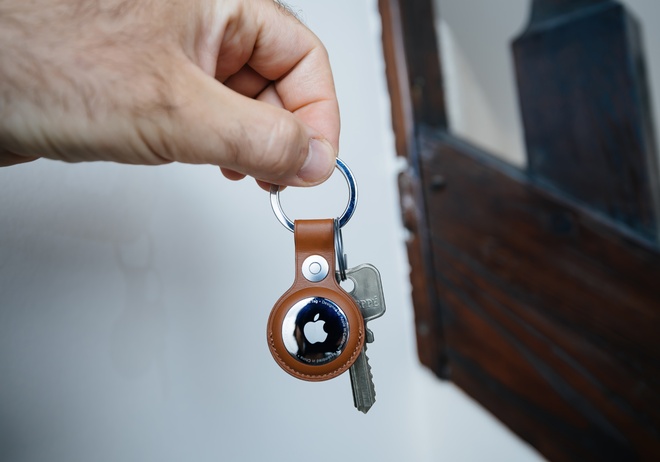How far does an AirTag work ?
The Apple AirTag has captured attention for its ability to locate lost items using Bluetooth Low Energy, Ultra-Wideband, and the Find My network. But what is the actual Bluetooth range, and how does the physical environment impact performance? In this article, we explore the typical and maximum tracking distances of an AirTag. We also explain how connection issues, Apple device proximity, and environmental conditions can affect its overall reliability.

Reading time : 5 min
CONTENTS
Understanding AirTag technology

Bluetooth and the AirTag
The AirTag's core functionality hinges on Bluetooth Low Energy (BLE), a technology that allows it to communicate with nearby Apple devices, such as iPhones, to transmit its location. BLE's key advantage is its low power consumption, which is essential for a small device like the AirTag that relies on limited battery life. This energy efficiency allows the AirTag to function for extended periods.
However, Bluetooth's range is relatively short, typically around 10 meters (or 30 feet) in open spaces. This means that once the AirTag moves beyond this distance from an Apple device, it loses its ability to communicate with it, rendering long-distance tracking impossible. For users hoping to track an item over extended distances, this can be a significant drawback.
Crowd GPS and Ultra Wideband (UWB) solutions
How it works
To address Bluetooth's limited range, the AirTag employs "Crowd GPS," a feature that enables detection by any nearby iOS device, forming a larger detection network. This network allows the AirTag to be tracked even if it is out of range of its owner's iPhone, provided there are other Apple users nearby. The effectiveness of Crowd GPS increases in urban areas, where there are more Apple devices.
Moreover, newer AirTag models include Ultra Wideband (UWB), a technology offering more precise short-range tracking compared to Bluetooth. UWB enables users to pinpoint objects with high accuracy, which is particularly useful in cluttered environments or indoors. This combination of UWB and Crowd GPS provides a comprehensive solution for locating items, even when they are far from their owner.
Limits
However, the effectiveness of Crowd GPS and UWB depends on specific factors, including the density of Apple devices in the area and the availability of UWB-compatible iPhones. In areas with fewer Apple devices or where older iPhone models are prevalent, Crowd GPS and UWB's effectiveness can diminish.
Durability and battery life: how reliable is an AirTag over time?
AirTags are designed with a robust design that withstands normal wear and tear in everyday use. Each unit is powered by a CR2032 battery, a replaceable battery that typically lasts about a year under regular conditions. Users receive push notifications via the Find My app when battery checks indicate it's time for a battery replacement. While this setup avoids the need for a rechargeable battery, it still ensures consistent operation thanks to efficient signal strength management.
In terms of resilience, AirTags feature an IP67 water and dust resistance rating, meaning they can endure brief submersion in water and resist dirt or particles. However, prolonged exposure may lead to water damage, especially in harsher environments. As such, while suitable for many use cases, AirTags aren't built for long-term outdoor tracking, especially when compared to dedicated pet GPS trackers like Weenect.
Technology constraints and compatibility
AirTag tracking relies on Bluetooth Low Energy and the Find My app. If the Apple ecosystem is sparse, only a last known location or “Not Reachable” alert may be shown. Older iPhones without the U1 chip can’t support Precision Finding. Without UWB technology, location updates may fail, creating untraceable tags in rural environments.
The Find My app also needs a nearby device with a stable internet connection. Without one, no location updates are sent, even if the AirTag is physically close. Each AirTag is tied to a single Apple ID. This prevents location sharing across users, which makes it hard for families to track the same AirTag together in real time. AirTags require iOS 14.5 or later, and work best with iOS 17. They don’t pair with Android or any NFC-enabled phone, making cross-platform use highly limited.
Things to check before buying a GPS
18 questions you need to ask yourself before buying a GPS tracker for your loved ones!
Durability and battery life

How reliable is an AirTag over time?
AirTags are designed with a robust design that withstands normal wear and tear in everyday use. Each unit is powered by a CR2032 battery, a replaceable battery that typically lasts about a year under regular conditions. Users receive push notifications via the Find My app when battery checks indicate it's time for a battery replacement. While this setup avoids the need for a rechargeable battery, it still ensures consistent operation thanks to efficient signal strength management.
In terms of resilience, AirTags feature an IP67 water and dust resistance rating, meaning they can endure brief submersion in water and resist dirt or particles. However, prolonged exposure may lead to water damage, especially in harsher environments. As such, while suitable for many use cases, AirTags aren't built for long-term outdoor tracking, especially when compared to dedicated pet GPS trackers like Weenect.
AirTag and pet tracking

AirTag's limitations for pets
The use of AirTags for pet tracking presents substantial challenges. The primary issue is Bluetooth's limited range. In open spaces, Bluetooth's effective range is only about 10 meters, making it insufficient for tracking pets that tend to wander far. An animal can quickly move beyond this range, making AirTag tracking unreliable, particularly in emergencies where every minute counts.
The second challenge arises from AirTag's reliance on Crowd GPS. This network's effectiveness hinges on the density of Apple devices nearby. In rural or less populated areas, where Apple devices are sparse, tracking can become ineffective. This inconsistency can be a major concern for pet owners living in or visiting rural areas.
Safety concerns
Another significant concern is safety. Apple has advised against using AirTags for pet tracking due to potential health risks. Veterinarians have reported incidents of animals swallowing these devices, posing serious health hazards. The Wall Street Journal also reported on these concerns, highlighting the importance of choosing tracking devices specifically designed for pets.
In comparison, alternative pet trackers use GPS and cellular networks, offering broader coverage and accurate tracking without depending on nearby devices. These trackers provide a more reliable solution for pet tracking.
Weenect: a better solution
Real-time tracking with no distance limits
Weenect provides GPS trackers specifically designed for dogs and cats. These trackers use a combination of GPS and cellular networks to offer extensive coverage and precise location tracking, regardless of distance. This provides real-time tracking, which is crucial in case an animal goes missing or escapes.
Features designed for animals
Weenect trackers are weather-resistant, securely attachable to pet collars, and include features such as a remote-activated flashlight, sound alerts for training, and activity tracking. This helps pet owners monitor their pets' movements, behaviors, and overall well-being.
Additionally, Weenect trackers offer long battery life, virtual safety zones, and personalized alerts, creating a comprehensive solution for reliable pet tracking. This ensures pet owners can track their pets effectively and securely, regardless of the environment or situation.
Conclusion
In conclusion, while Apple's AirTag provides notable technological advancements for locating personal items, it shows significant limitations when used for pet tracking. Its short 10 meters range and dependence on nearby Apple devices present major drawbacks. In contrast, Weenect GPS trackers offer a more suitable alternative, ensuring accurate tracking and peace of mind for pet owners through technology designed specifically for animal tracking.
With Weenect trackers, pet owners can enjoy real-time tracking, no distance limits, and features tailored to animals, making it a reliable choice for pet tracking. This combination ensures that even if an animal goes missing, pet owners have the tools to track them effectively.
Read more about our guide
This article is part of a complete guide on the subject. Don't miss the other chapters.
Are you looking for the best GPS tracker ?
18 questions you need to ask yourself before buying a GPS tracker

